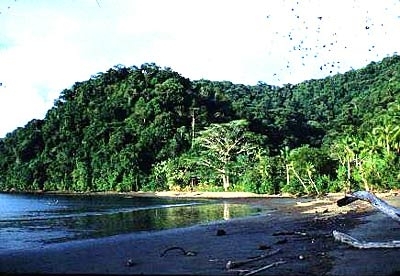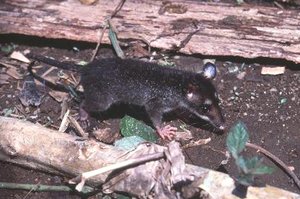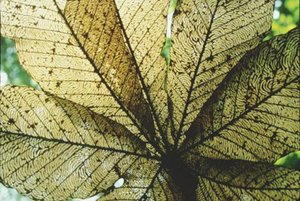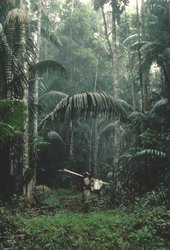Chocó-Darién moist forests
The Chocó-Darien moist forests ecoregion is one of the most species rich lowland areas in the world, with exceptional abundance and endemism over a broad range of taxa including plants, birds, amphibians and arthropods. The biological distinctiveness is exceptional, with considerablebiodiversity. It is classified within the Tropical and Subtropical Broadleaf Forests biome.
Due to multiple threats within the ecoregion, its conservation status is vulnerable, although relatively stable due to its remoteness. There are, however threats of habitat destruction and the attendant degradation, in areas with insufficient conservation. In addition, this ecoregion is culturally rich in that certain indigenous communities with strong ties to its ecosystems still persist here.
Contents
Location and General Depiction
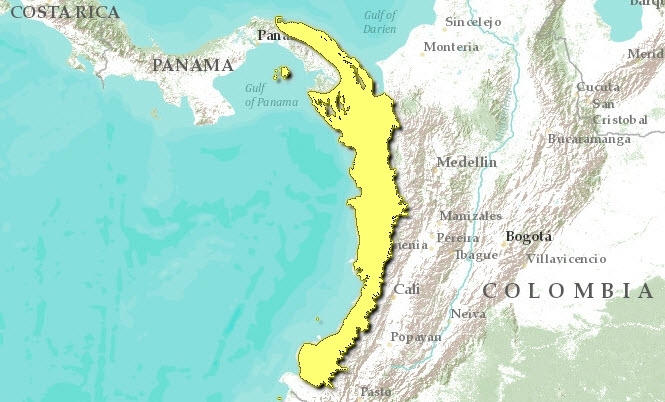
The ecoregion of the wet forests of Chocó-Darién extends from eastern Panama, in the provinces of Darién and Kuna-Yala, along almost the entire Pacific coast of Colombia, in the departments of Chocó, Cauca, Valle del Cauca, and Nariño, thus extending between latitudes 9º to 1º15’ north, then down to 2°S and longitudes 79º to 76º15’ west. This ecoregion encompasses a strip of land from sea level to an elevation of approximately 1000 meters (m). It lies between the Pacific Ocean and the western range of the Andes; from west of the mouth of the Atrato River, in Panama to the Patia River, in Colombia.
There are five distinct subregions. First the northern coast, with the hill country areas of Darién and Urabá. Second the [[coast]al zone] along the Pacific coast, generally up to an elevation of 500 m. Third the central strip, including the northern wet forests, the central rainforests and the San Juan River area. Fourth the hills of Carmen del Atrato and the San José del Palmar area and finally the jungles along the Pacific slope from 500 to 1000 m in altitude. The mountainous areas include the western slopes of Cordillera Occidental and land massifs such as Cerro Torrá, Serranía del Darién, and Sierra Llorona de San Blas and Serranía del Baudó .
Average annual temperature is generally 23.6ºC, with a maximum average of 30ºCelsius and a minimum of 18.6ºC. The biogeographic Chocó is probably the only ecoregion of this size with the precipitation, from 4000 to more than 9000 millimeters (mm) per year. It is also one of the few places in the Neotropics with pluvial rainforest. Precipitation in the ecoregion varies - with less in the northern zone, higher amounts in the central region and less again in the south. Some sectors may receive more than 13,000 mm of precipitation per year. There are areas toward Panama and the Caribbean Sea to the north and then south that have short dry seasons, generally from January to March.
There are three principal geomorphologic types in the ecoregion: alluvial plains of recent origin, low mountains formed by the relatively recent dissection of sediments from the Tertiary and Pleistocene periods, and the complexes in mountain areas consisting of mesozoic rocks. The high precipitation and the topography mean that the ecoregion includes a complex of great hydrographic basins, the most important being those of the Atrato, Baudó, and San Juan Rivers and the Micay and Patía Rivers in the south. The force of the water in many of these rivers form deep gorges cutting through the mountains, creating spectacular rapids and waterfalls in the mountains, along the upper courses. At lower elevations, large rivers become very wide and with many meanders. Given the high precipitation in the region, it is not surprising that the soils are severely leached and poor in nutrients. Most of the ecoregion has typical laterite soils with reddish clay, although the soils are younger and less leached in some areas, especially close to the base of the Andes and in the floodplains of the major rivers. Of particular botanical interest are the white clay soils in the region of Bajo Calima in Colombia, which are associated with the gigantic sclerophyllous leafed and unusually large fruited vegetation.
Depending on the altitudinal gradient, soil water content and the effect of the sea, there are various types of vegetation that make up the ecoregion. In broad terms, in the northern part of the ecoregion, the lowland rainforests correlate to the Brosimun utilis alliance, including communities dominated by the deciduous Cuipo tree (Cavanillesia platanifolia), the Espavé wild cashew (Anacardium excelsum), the Panamanian rubber tree (Castilla elastica), Brosimum guianense, Bombacopsis spp., Ceiba pentandra, Dipteryx panamensis, and others. In the undergrowth Mabea occidentalis, Clidemia spp., Conostegia spp. and Miconia spp. are abundant. In zones that are occasionally flooded, the "cativo" (Prioria copaifera) flourishes as well. In the southern part of the ecoregion, these rainforests have multiple strata, with two layers of trees, lianas, and epiphytes with vigorous growth rates. The number of deciduous plants increases in the north and south, where there is a dry season, particularly near the coast. The forests at higher altitudes, starting at 600 meters, have communities with the following species: "guamos" (Inga spp.), Billia columbiana, Brosimum sp., Sorocea spp., Jacaranda hesperia, Pourouma chocoana, Guatteria ferruginea, Cecropia spp., Elaegia utilis, and Brunellia spp.
Biodiversity Features
Chocó-Darién corresponds to one of the largest active centers of speciation and endemism in the world. The flora of Chocó is estimated at a minimum of 8000 species of vascular plants and possibly more than 10,000 with nearly twenty percent strictly endemic. Although there are no endemic families, there are endemic genera, some of which have undergone a considerable amount of speciation, including Trianaeopiper and Cremosperma. Local endemism is characteristic of the region, indicating that many species have very restricted ranges of distribution and giving rise to an extraordinary beta-diversity, i.e., diversity related to high variation from one location to another in the ecoregion. There is thought to be occurring an active speciation in epiphytes, vascular plants "bijaguas" (Heliconia, Costus), and shrubs.
In the central zone of the ecoregion, we find a mosaic of rainforests at higher elevations and very wet or wet forests in the lower [[coast]al] ranges. These rainforests of the Chocó have distinct plant life that is usually confined to cloud forests at medium elevations (approximately 1000 meters above sea level). It includes characteristics such as thick moss cover and other non-vascular epiphytes on trunks and branches and the prevalence of woody hemi-epiphytic lianas belonging to the families Ericaceae, Marcgraviaceae, and Melastomataceae, all of which have centers of diversity in the region. In addition, there are high densities of slender trees with associated low biomass density. In the areas to the north and south of the ecoregion, a different type of rainforest in terms of physiognomy and plantlife occurs. These forests have large emergent trees and a high biomass. The extraordinary amount of rainfall in this area acts as a barrier to many vertebrates, and presents a gap in the distribution of many mammals, including a number of primate taxa.
The ecoregion of Darién-Chocó also has high diversity and endemism with regard to fauna. There are 97 species of reptiles that have been recorded in the ecoregion with Colubridae listed as the most diverse family, with 35 species, followed by Iguanidae, with 26 species. Many taxa are Endangered (EN); Critically Endangered (CR); Vulnerable (VU); or Near Threatened (NT) according to the 1996 IUCN red list.
Amphibians
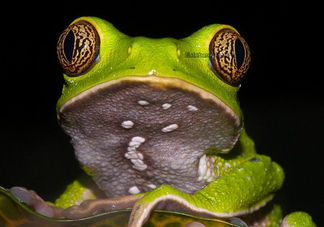 Lovely leaf frog. @ Estaban Alzate There are at least 127 species of amphibians in the Choco-Darien, including the following endemic anuran species:Isla Bonita robber frog (Craugastor crassidigitus); Kokoe poison frog (Phyllobates aurotaenia NT), found on western slopes of the Cordillera Occidental , along the Rao San Juan drainage south to the Rao Raposo; Golden poison frog (Phyllobates terribilis EN); La Brea poison frog (Oophaga occultator); Andagoya robber frog (Pristimantis roseus); Antioquia beaked toad (Rhinella tenrec); Atrato glass frog (Hyalinobatrachium aureoguttatum); Blue-bellied poison arrow frog (Ranitomeya minuta); Colombian egg frog (Ctenophryne minor), known only to the in the upper Rao Saija drainage; Condoto stubfoot toad (Atelopus spurrelli VU); Flecked leaf frog (Phyllomedusa psilopygion); LeDanubio robber frog (Strabomantis zygodactylus). An endemic salamander present in the Choco-Darien is the Finca Chibigui salamander (Bolitoglossa medemi VU).
Lovely leaf frog. @ Estaban Alzate There are at least 127 species of amphibians in the Choco-Darien, including the following endemic anuran species:Isla Bonita robber frog (Craugastor crassidigitus); Kokoe poison frog (Phyllobates aurotaenia NT), found on western slopes of the Cordillera Occidental , along the Rao San Juan drainage south to the Rao Raposo; Golden poison frog (Phyllobates terribilis EN); La Brea poison frog (Oophaga occultator); Andagoya robber frog (Pristimantis roseus); Antioquia beaked toad (Rhinella tenrec); Atrato glass frog (Hyalinobatrachium aureoguttatum); Blue-bellied poison arrow frog (Ranitomeya minuta); Colombian egg frog (Ctenophryne minor), known only to the in the upper Rao Saija drainage; Condoto stubfoot toad (Atelopus spurrelli VU); Flecked leaf frog (Phyllomedusa psilopygion); LeDanubio robber frog (Strabomantis zygodactylus). An endemic salamander present in the Choco-Darien is the Finca Chibigui salamander (Bolitoglossa medemi VU).
Some other non-endemic anurans found here are: Anatipes robber frog (Strabomantis anatipes); Banded horned treefrog (Hemiphractus fasciatus); Black-legged poison frog (Phyllobates bicolor NT); Horned marsupial frog (Gastrotheca cornuta EN), known for having the largest amphibian eggs in the world; El Tambo stubfoot toad (Atelopus longibrachius EN); Elegant stubfoot toad (Atelopus elegans CR).
Endemic caecilians in the ecoregion include: Andagoya caecilian (Caecilia perdita);
Reptiles
There are a number of reptilian taxa within the ecoregion, including: Adorned graceful brown snake (Rhadinaea decorata); the endemic Black centipede snake (Tantilla nigra); Boulenger's least gecko (Sphaerodactylus scapularis VU); the endemic Iridescent ground snake (Atractus iridescens); the endemic Cauca coral snake (Micrurus multiscutatus); the endemic Colombian coral snake (Micrurus spurelli); the endemic Dark ground snake (Atractus melas); the endemic Colombian mud turtle (Atractus melas VU); and the endemic Echternacht's ameiva (Ameiva anomala).
Birdlife
There are 577 species of birds recorded; Tyrannidae is listed as the most diverse avian family, presenting 28 genera and 60 species within the ecoregion. The Choco-Daroemis is a center of avian endemism of the Neotropics; moreover, according to Stattersfield, this ecoregion spans two Endemic Bird Areas, one in Central America and one in South America.
Between these two Endemic Bird Areas there are over sixty restricted range species, including the Chocó tinamou (Crypturellus kerriae VU), Chestnut-mantled Oropendola (Psarocolius cassini EN), Viridian dacnis (Dacnis viguieri), Crested ant-tanager (Habia cristata), Lita woodpecker (Piculus litea), and Plumbeous forest-falcon (Micrastur plumbeus EN). Also to be noted is the presence of the Harpy eagle (Harpia harpyja), the Black and white crowned eagle (Spizastur melanoleucus), taxa increasingly rare in many areas of the Neotropics, and possibly the Speckled antshrike (Xenornis setifrons EN) although one has not been recorded in Colombia since the 1940s.
Mammals
 Baird's tapir. @ Brian Gatwicke/EoL The region is rich in mammalian taxa, but the larger animals have received inadequate research. These include the Bush dog (Speothos venaticus NT); Chocó tamarin (Saguinus geoffroyi EN), the Baird's Tapir (Tapirus bairdii EN), the Giant anteater (Myrmecophaga tridactyla VU), the Brown-headed spider monkey (Ateles fuscipens CR), the Puma (Puma concolor VU), the Ocelot (Leopardus pardalis LC), and the jaguar (Panthera onca NT). LC is the designation for Least Concern.
Baird's tapir. @ Brian Gatwicke/EoL The region is rich in mammalian taxa, but the larger animals have received inadequate research. These include the Bush dog (Speothos venaticus NT); Chocó tamarin (Saguinus geoffroyi EN), the Baird's Tapir (Tapirus bairdii EN), the Giant anteater (Myrmecophaga tridactyla VU), the Brown-headed spider monkey (Ateles fuscipens CR), the Puma (Puma concolor VU), the Ocelot (Leopardus pardalis LC), and the jaguar (Panthera onca NT). LC is the designation for Least Concern.
Ecological Status
According to the evaluation of Dinerstein et al. in 1995, the ecoregion has lost between ten and twenty percent of the original habitat. The habitat blocks are sizable, with minimal fragmentation and high biological connectivity, which still allows dispersion over long distances through altitudinal and climatic gradients. The annual habitat conversion rate or percentage of intact habitat that is degraded each year from during the period 1990-1995 is estimated to be 3.5 percent, a relatively high value.
Protected areas are limited in size considering the size of the ecoregion and the great diversity of different ecosystems, and thus the protection system is deficient. The existence of extensive areas of lowland forests and medium elevations represents one of the last opportunities to conserve relatively large areas of intact forest in the northwestern section of South America. In addition, this characteristic allows the natural altitudinal migration of many species of birds, mammals, and invertebrates, a phenomenon that is increasingly rare in the tropics as its forests are being destroyed. The region has great potential for ecotourism and scientific research. Its forests are of great interest because some of them may be secondary forests that are nearly 500 years old, which would clearly allow for studies on the subject of the regeneration of tropical forests. The areas with remaining vegetation correspond to the central area of the ecoregion, while the northern areas of Darién and Urabá, in Colombia are devoted primarily to the production of bananas and cattle ranching. Southern areas of Bajo Calima and Tumaco, are devoted in part to plantations for the production of oil palm and extraction of timber for paper pulp are those that require greater urgency and efforts for their protection and conservation. It is estimated that the rate of deforestation is 600 square kilometers (km2) per year.
Originally, in Panama, this ecoregion covered approximately 13,335 km2. Nearly 30% of this area, about 4000 km2, is under some type of protection in parks and reserves. The most important is the Darien National Park, covering 597,000 hectares (representing less than one tenth of the entire ecoregion), with management categories II and X (Biosphere Reserve), and also a UNESCO World Heritage Site. Next there is the Kuna-Yala indigenous reserve (3200 km2) and the Embera Wounan reserve (4326 km2). An additional forty percent of the ecoregion is found in areas considered to be potential parks, and five percent is found in mining reserves. A third section of the area of this ecoregion in the Panamanian sector has a significant fraction devoted to agriculture.
In Colombia, where most of the ecoregion is found, the largest protected areas cover an area equal to only about one percent of the total original habitat, and these areas are quite distant from each other. On the Colombian side, a total of approximately 2013 km2 of the ecoregion is protected in national parks or 2.5 percent of the total ecoregion. Bordering on the east with the Darien National Park, in Panama, is the Los Katios National Park, covering an area of 720 km2. The Utria National Park, covers an area of 543 km2 including a land and a marine sector while the Sanquianga National Park covers 800 km2 and the Gorgona Island National Park covers 16 km2 of protected land. The lowland portions of Farallones de Cali National Park and Munchique National Park are included in this value. Additional areas must be delineated and their protection advanced, including the area lying between the Atrato, Baudó, and San Juan Rivers, the area between the Calima and Patía Rivers and the western lowlands of the department of Nariño.
The lack of sufficient taxonomic and geographic data on this ecoregion makes adequate management plans difficult, and thus much additional work is needed. More detailed flora and ecological studies are needed on the ecoregion, as well as on the patterns of distribution of plant communities. The need for conducting studies in the region is a priority, as there are still large undisturbed areas.
Ecological Threats
The resources in these forests have been over-exploited for years, although the benefits have not devolved to indigenous groups (Kuna, Emberá, Wounana, Eperara, Afro-descendants, Mestizos and others). Due to numerous ecological threats in the ecoregion, its conservation status is vulnerable. There are threats of habitat conversion and the degradation associated with it, in an insufficient system of conservation areas.
The major threat to this ecoregion is deforestation. In the Darien region, the major threat is the construction of the Inter-American Highway and the degradation associated with it. The forests of Chocó, although they represent only one-sixth of [[Colombia]n] forests, supply more than half of the timber in the country. This deforestation also entails serious problems of erosion, affecting the different ecosystems of the region, including the [[coast]al] areas. Another pressing threat in Chocó is industrial development. The government has built a naval base at the mouth of Málaga Bay, an important place for Humpback whale reproduction. Industrial production of African palm oil (Elaeis guineensis), uncontrolled gold mining and illegal growing of coca add to the list of causes of deforestation.
Justification of Ecoregion Delineation
This ecoregion is designated NT0115 by the World Wildlife Fund, and it lies within the Neotropical realm. The delineations for this ecoregion were derived from two national vegetation maps, that of Panama and of Colombia. The northern limits of this ecoregion in Panama follow UNDP’s classification of humid tropical forest and very humid tropical forest, and the arching line from the Pacific to the Caribbean denoted the transition from Chocó influence in Panama to isthmanian species associations.
Montane regions were then distinguished from this primarily lowland ecoregion. Within Colombia, linework was derived by combining all Pacific heterogeneous dense forests: "piedmont cordillera forests", "hydrophilic (riparian) forest", and "escarpment cordillera forests" of the Chocó region. From this, one can separate all mangrove forest classifications and draw the southern delineation along the Patia River, which acts as a barrier to dispersal of many species. This ecoregion is distinct in its incredible [[species rich]ness] and high levels of endemic species. It is also an important convergence zone for elements of South and Central American influence.
Neighboring Ecoregions
- Northwestern Andean montane forests, to the east
- Western Ecuador moist forest, to the south-southwest
- South American Pacific mangroves, at the southwest
- Isthmian-Atlantic moist forests, at the northwest
- Amazon-Orinoco Southern Caribbean mangroves, at the north-northwest
- Magdalena-Uraba moist forests, at the northeast
References
- Baillie, J and B. Groombridge, editor. 1996 IUCN Red List of Threatened Animals (The 1996 IUCN Red Data Book). IUCN, The World Conservation Union. Gland, Switzerland. ISBN: 2831703352
- Barnes, J. 1993. Driving roads through land rights. The Colombian Plan Pacífico. The Ecologist 23(4):135-140.
- Budowski, G. 1989. Developing the Chocó region of Colombia. In: J.O. Browder, Fragile Lands of Latin America. Strategies for Sustainable Development. Westview Press, Boulder, USA. ISBN: 0813377056
- Budowski, G. 1990. Desarrollo sostenible: el caso de la Provincia Fitogeográfica del Chocó. In INDERENA, ECOBIOS, Colombia 88. El desarrollo sostenible: estrategias, políticas y acciones. Septiembre 20-23, 1988. Memorias del Simposio Internacional, Bogotá, Colombia. Ministerio de Agricultura, INDRENA, Bogotá.
- Caribbean Environmental Programme (CEP) 1996. Status of Protected Area Systems in the Wider Caribbean Region. CEP Technical Report No. 36
- CONIF. 1985. Región del Chocó (Colombia). Bibliografía (1951-1984). Serie de Documentación No. 7, Bogotá.
- Davis, S.D., V.H. Heywood, O. Herrera-MacBryde, J. Villa-Lobos, and A.C. Hamilton, editors. 1997. Centres of Plant Diversity. A Guide and Strategy for their Conservation. Volume 3: The Americas. World Wildlife Fund and IUCN. ISBN: 283170197X
- Dinerstein, E., D.M. Olson, D.L. Graham, A.L. Webster, S.A. Primm, M.P. Bookbinder, and G. Ledec. 1995. A Conservation Assessment of the Terrestrial Ecoregions of Latin America and the Caribbean. The World Bank. ISBN: 0821332961
- Faber-Langendoen, D. and Gentry, A.H. 1991. The structure and diversity of rain forests at Bajo Calima, Chocó region, western Colombia. Biotropica 23:2-11.
- Gentry, A.H. 1982. Phytogeographic patterns as evidence for a Chocó refuge. In G.T. Prance, editor, Biological Diversification in the Tropics. Columbia University Press, New York, USA. ISBN: 0231048769
- Gentry, A.H. 1986. Species richness and floristic composition of Chocó region plant communities. Caldasia 15:71-91.
- Gentry, A.H. 1989. Northwest South America (Colombia, Ecuador and Perú). In D.G. Campbell, and H.D. Hammond, editors, Floristic Inventory of Tropical Countries: The Status of Plant Systematics, Collections, and Vegetation, Plus Recommendations for the Future. New York Botanical Gardens, Bronx, USA. ISBN: 0893273333
- Gentry, A.H. 1992. Tropical forest biodiversity: distributional patterns and their conservational significance. Oikos 63:19-28.
- Gentry, A.H. 1993. Riqueza de especies y composición florística. In P. Leiva-F., editor, Colombia pacífico, Vol. 1. Fondo protección del medio ambiente José Celestino Mutis, Publicaciones Financiera Eléctrica Nacional (FEN), Santafé de Bogotá, Colombia.
- Harcourt, C., & J. Sayer, editors. 1996. The Conservation Atlas of Tropical Forests: The Americas. Simon & Schuster, NYC, USA. ISBN: 0133408868
- INDERENA 1993. Conservación de la biodiversidad del Chocó biogeográfico. Plan operativo. INDERENA, Bogotá, Colombia.
- INRENARE y ANCON 1988. De manejo y desarrollo integrado Reserva de la Biósfera Darién, basado en la labor de R.E. Weber. Instituto Nacional de Recursos Naturales Renovables (INRENARE) y Asociación Nacional para la Conservación de la Naturaleza (ANCON), Ciudad de Panamá, Panamá.
- IUCN, 1982. IUCN Directory of Neotropical Protected Areas. Tycooly International Publishing Limited, Dublin. ISBN: 0907567622
- IUCN Conservation Monitoring Center, 1988. Colombian Chocó. Conservation of biological diversity and forest ecosystems. IUCN Tropical Forest Programme.
- IUCN 1998. 1997 United Nations List of Protected Areas. Prepared by UNEP-WCMC and WCPA. IUCN, Gland, Switzerland and Cambridge, UK. ISBN: 283170426X
- Li, X., T. Boucher, R. Sayre, J. Courrau, y M. Connor. 1999. Evaluación de conservación de la vegetación y las ecorregiones de Centroamérica. Enfoque de análisis de brechas.
- Olson, D., E. Dinerstein, G. Castro, and E. Maravi. 1996. Identifying gaps in botanical information for biodiversity conservation in Latin America and the Caribbean. World Wildlife Fund, Washington, D.C., USA.
- Olson, D. and E. Dinerstein. 1997. The Global 200: A Representation Approach to Conserving the Earth’s Distinctive Ecoregions. World Wildlife Fund, Washington, D.C., USA.
- Rangel-Ch., J.O., O. Castaño, F.G. Stiles, et al. 1994. Diagnóstico inicial de la biodiversidad en Colombia. Resúmenes del IV Congreso Colombiano de Ecología. Sociedad Colombiana de Ecología. Melgar, Colombia.
- Roa, S. and R. Ruiz. 1993. Anfibios. In J.O. Rangel-Ch., editor, Informe Proyecto Estudio de la Biodiversidad de Colombia. Convenio INDERENA-Universidad Nacional de Colombia, Bogotá. Internal Document.
- Roda, J. and G. Styles. 1993. Aves. In J.O. Rangel-Ch., editor, Informe Proyecto Estudio de la Biodiversidad de Colombia. Convenio INDERENA-Universidad Nacional de Colombia, Bogotá. Internal Document.
- Sánchez, H. y O. Castaño. 1994. La biodiversidad de los reptiles en Colombia. In J.O. Rangel-Ch., editor, Informe Proyecto Estudio de la Biodiversidad de Colombia. Convenio INDERENA-Universidad Nacional de Colombia, Bogotá. Internal Document.
- Stattersfield, A.J., M.J. Crosby, A.J. Long, and D.C. Wege. (in press). A Global Directory of Endemic Bird Areas. BirdLife Conservation Series. BirdLife International, Cambridge, U.K.
- Suarez-Navarro, A.E., et al. 1984. Bosques de Colombia. IGAC-INDERENA-CONIF, Bogota, Colombia.
- UNDP. 1970. Mapa ecólogico de Panama. Map 1:5,000,000. Programa de las Naciones Unidas para el Desarrollo, Panama City, Panama.
- UNEP-WCMC, 1994. World Heritage Site: Los Katíos National Park, Columbia.
- UNEP-WCMC, 1995. World Heritage Site: Darién National Park, Panama.
- Wege, D.C., and A.J. Long. 1995. Key Areas for Threatened Birds in the Neotropics. Birdlife International, Smithsonian, Washington, D.C., USA. ISBN: 0946888310
- West, R. C. 1957. The Pacific lowlands of Colombia: a Negroid area of the American tropics. Louisiana State University Studies, Soc. Sci. Ser. No. 8. Louisiana State University Press, Baton Rouge.
- WWF 1993. Colombia’s biologically rich Chocó forest faces increasing threats. Focus 15(2):1-6.
